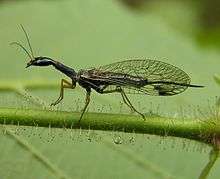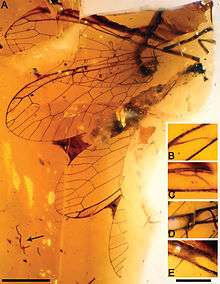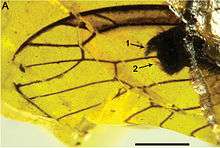Snakefly
| Snakefly Temporal range: Lower Jurassic–Recent | |
|---|---|
 | |
| Female Dichrostigma flavipes | |
| Scientific classification | |
| Kingdom: | Animalia |
| Phylum: | Arthropoda |
| Class: | Insecta |
| Infraclass: | Neoptera |
| (unranked): | Eumetabola |
| (unranked): | Endopterygota |
| Order: | Raphidioptera Handlirsch, 1908 |
| Suborders | |
|
see text | |
| Synonyms | |
| |
Snakeflies are a group of insects comprising the order Raphidioptera, consisting of about 210 extant species.[1] Together with the Megaloptera they were formerly placed within the Neuroptera, but now these two are generally regarded as separate orders.
Snakeflies are predatory, both as adults and larvae. They can be quite common throughout temperate Europe and Asia, but in North America occur exclusively in the Western United States, namely in the Rocky Mountains and westward, including the southwestern deserts.
The etymology of the name for the order, Raphidioptera, comes from the Greek "raphio", which means needle, and "ptera", which means wings.
Anatomy and life cycle
Adult snakeflies are characterized by having an elongate prothorax but no modification of the forelegs (as in Mantispidae). They have strong and relatively unspecialised mouthparts, and large compound eyes. Some species also have ocelli. The females typically have a long ovipositor, which they use to deposit their eggs into crevices in bark or rotting wood. The two pair of dragonfly-like wings are similar in size, with a primitive venation pattern, and a thickened costal margin (or "pterostigma").[2] Whereas the dragonfly rests with its wings outstretched, the snakefly folds its wings together long its abdomen.
The larvae have large heads with projecting mandibles. The head and the first segment of the thorax are sclerotised, but the rest of the body is soft and fleshy. They have three pairs of true legs, but no prolegs. However, they do possess an adhesive organ on the abdomen, which they can use to fasten themselves to vertical surfaces.[2]
The final larval instar creates a cell in which the insect pupates. However, they do not create a cocoon, and the pupa is fully capable of movement, and often leaves its cell for another location before the adult emerges. The larvae can take up to two years to develop.[2]
Systematics
Distinguishing taxonomic features
The morphological characteristics which distinguish the order Raphidioptera from other insect orders are as follows :[3]
- prothorax is lengthened.
- head has protuding eyes, long antennae and mandibles (chewing mouthparts).
- has two pairs of identical wings.
- ten-segmented abdomen without cerci.
- lengthened ovipositors.
Taxonomy
The Megaloptera, Neuroptera (in the modern sense) and Raphidioptera are very closely related, forming the group Neuropterida. This is either placed at superorder rank, with the Endopterygota - of which they are part - becoming an unranked clade above it, or the Endopterygota are maintained as a superorder, with an unranked Neuropterida being a part of them. Within the endopterygotes, the closest living relatives of Neuropterida are the beetles.
The two extant families of snakeflies are the Raphidiidae and Inocelliidae. In addition, there are four extinct families known only from fossils.[4] Almost all known snakeflies belong to the suborder Raphidiomorpha.[4] The exception being the Jurassic family Priscaenigmatidae, placed in suborder Priscaenigmatomorpha.[4]
Extinct snakeflies are known from fossils dating from the Lower Jurassic to the Miocene.[4]
Raphidioptera as grouped according to Engel 2002 with updates according to Bechly and Wolf-Schwenninger, 2011 and Ricardo Pérez-de la Fuente et al (2012):[4][5][6]
Order Raphidioptera
- Suborder †Priscaenigmatomorpha Engel 2002
- Family †Priscaenigmatidae Engel, 2002
- Genus †Hondelagia Bode, 1953 (Lower Jurassic; Germany)
- Genus †Priscaenigma Whalley, 1985 (Lower Jurassic; England)
- Family †Priscaenigmatidae Engel, 2002
- Suborder Raphidiomorpha
- Family †Baissopteridae Martynova, 1961
- Genus †Austroraphidia Willmann, 1994 (Lower Cretaceous; Brazil)
- Genus †Baissoptera Martynova, 1961 (Upper Jurassic-Lower Cretaceous; Brazil, China, Russia)
- Genus †Cretoraphidia Ponomarenko, 1993 (Upper Jurassic-Lower Cretaceous; Russia)
- Genus †Cretoraphidiopsis Engel, 2002 (Lower Cretaceous; Mongolia)
- Genus †Lugala Willmann, 1994 (Lower Cretaceous; Mongolia)
- Family Inocelliidae Navás
- Subfamily †Electrinocelliinae Engel, 1995
- Genus †Electrinocellia Engel, 1995 (Eocene; Baltic amber)
- Subfamily Inocelliinae Engel, 1995
- Genus Amurinocellia Aspöck & Aspöck, 1973 (Recent)
- Genus Fibla Navás, 1915 (Eocene-Recent; Fossils: Baltic amber, Spain, USA)
- Genus Indianoinocellia (Recent)
- Genus Inocellia Schneider, 1843 (Recent)
- Genus Negha Navas 1916 (Recent)
- Genus Parainocellia (Recent)
- Genus Sininocellia (Recent)
- Genus †Succinofibla Aspöck & Aspöck, 2004 (Eocene; Baltic amber)
- Subfamily †Electrinocelliinae Engel, 1995
- Family †Metaraphidiidae Bechly and Wolf-Schwenninger, 2011
- Genus †Metaraphidia Whalley, 1985 (Lower Jurassic; England, Germany)
- Family †Mesoraphidiidae Martynov, 1925 (= Alloraphidiidae, Huaxiaraphidiidae, Sinoraphidiidae, and Jilinoraphidiidae)
- Subfamily Alloraphidiinae
- Genus Alloraphidia Carpenter, 1967 (Upper Jurassic-Middle Cretaceous; Canada, China, Mongolia, Russia)
- Genus Archeraphidia Ponomarenko, 1988 (Upper Jurassic-Lower Cretaceous; Russia, Mongolia)
- Genus Pararaphidia Willmann, 1994 (Upper Jurassic-Lower Cretaceous; Russia, Mongolia)
- Subfamily Mesoraphidiinae
- Genus Baisoraphidia Ponomarenko, 1993 (Upper Jurassic-Lower Cretaceous; Russia)
- Genus Cretinocellia Ponomarenko, 1988 (Lower Cretaceous; Mongolia)
- Genus Huaxiaraphidia Hong, 1992 (Lower Cretaceous; China)
- Genus Jilinoraphidia Hong and Chang, 1989 (Lower Cretaceous; China)
- Genus Kezuoraphidia Willmann, 1994 (Lower Cretaceous; China)
- Genus Mesoraphidia Martynov, 1925 (Upper Jurassic-Upper Cretaceous; China, Kazakhstan, Mongolia, USA)
- Genus Proraphidia Martynova, 1947 (Upper Jurassic-Lower Cretaceous; England, Kazakhstan, Spain)
- Genus Siboptera Ponomarenko, 1993 (Upper Jurassic-Lower Cretaceous; China, Russia)
- Genus Sinoraphidia Hong, 1982 (Upper Jurassic; China)
- Genus Xuraphidia Hong, 1992 (Lower Cretaceous; China)
- Genus Yanoraphidia Ren, 1995 (Cretaceous)
- Tribe Nanoraphidiini
- Genus Cantabroraphidia Pérez-de la Fuente, Nel, Peñalver & Delclòs, 2010 (Albian; Spain)
- Genus Grimaldiraphidia Bechly and Wolf-Schwenninger, 2011 (Turonian, New Jersey, USA)
- Genus Nanoraphidia Engel, 2002 (Albian; Myanmar)
- Genus Lebanoraphidia Bechly & Wolf-Schwenninger, 2011 (Neocomian, Lebanon)
- Subfamily Ororaphidiinae
- Genus Caloraphidia Ren, 1997 (Cretaceous, China)
- Genus Necroraphidia Pérez-de la Fuente, Peñalver, Delclòs & Engel, 2012 (Albian, Spain)
- Genus Ororaphidia Engel & Ren 2008 (Middle Jurassic; China)
- Genus Styporaphidia Engel & Ren 2008 (Middle Jurassic; China)
- Subfamily "incertae sedis"
- Genus Alavaraphidia Pérez-de la Fuente, Peñalver, Delclòs & Engel, 2012 (Albian, Spain)
- Genus Amarantoraphidia Pérez-de la Fuente, Peñalver, Delclòs & Engel, 2012 (Albian, Spain)
- Genus Iberoraphidia Jepson, Ansorge & Jarzembowski, 2011 (Cretaceous)
- Subfamily Alloraphidiinae
- Family Raphidiidae Latreille
- Genus Africoraphidia (Recent)
- Genus Agullla Navas 1914 (Recent)
- Genus Alena Navas 1916 (Recent)
- Genus Atlantoraphidia (Recent)
- Genus Calabroraphidia (Recent)
- Genus Dichrostigma (Recent)
- Genus Harraphidia (Recent)
- Genus Hispanoraphidia (Recent)
- Genus Iranoraphidia (Recent)
- Genus Italoraphidia (Recent)
- Genus Mauroraphidia (Recent)
- Genus Mongoloraphidia (Recent)
- Genus Ohmella H. Aspöck & U. Aspöck (Oligocene-Recent)
- Genus Ornatoraphidia (Recent)
- Genus Parvoraphidia (Recent)
- Genus Phaeostigma (Recent)
- Genus Puncha (Recent)
- Genus Raphidia Linnaeus, 1758 (Eocene-Recent)
- Genus Raphidilla (Recent)
- Genus Subilla (Recent)
- Genus Tadshikoraphidia (Recent)
- Genus Tauroraphidia (Recent)
- Genus Tjederiraphidia (Recent)
- Genus Turcoraphidia (Recent)
- Genus Ulrike (Recent)
- Genus Venustoraphidia (Recent)
- Genus Xanthostigma (Recent)
- Family Incertae sedis
- Genus †Archiinocellia Handlirsch, 1910 (Oligocene; Canada)
- Genus †Arariperaphidia Martins-Neto & Vulcano, 1989 (Lower Cretaceous; Brazil)
- Family †Baissopteridae Martynova, 1961
Footnotes
- ↑ Jepson, J.E.; Jarzembowski, E.A. (2008). "Two new species of snakefly (Insecta:Raphidioptera) from the Lower Cretaceous of England and Spain with a review of other fossil raphidiopterans from the Jurassic/Cretaceous transition" (PDF). Alavesia 2: 193–201.
- 1 2 3 Hoell, H.V., Doyen, J.T. & Purcell, A.H. (1998). Introduction to Insect Biology and Diversity, 2nd ed. Oxford University Press. pp. 445–446. ISBN 0-19-510033-6.
- ↑ Gillot, C. (1995). "Raphiodioptera". Entomology (2 ed.). pp. 293–295. ISBN 978-0-306-44967-3. Retrieved 14 November 2010.
- 1 2 3 4 5 Engel, M.S. (2002). "The Smallest Snakefly(Raphidioptera: Mesoraphidiidae): A New Species in Cretaceous Amber from Myanmar, with a Catalog of Fossil Snakeflies". American Museum Novitates 3363: 1–22. doi:10.1206/0003-0082(2002)363<0001:TSSRMA>2.0.CO;2. hdl:2246/2852.
- ↑ Pérez-de la Fuente, R.; Peñalver, E.; Delclòs, X.; Engel, M.S. (2012). "Snakefly diversity in Early Cretaceous amber from Spain (Neuropterida, Raphidioptera)". ZooKeys 204: 1–40. doi:10.3897/zookeys.204.2740. PMC 3391719. PMID 22787417.
- ↑ Bechly, G.; Wolf-Schwenninger, K. (2011). "A new fossil genus and species of snakefly (Raphidioptera: Mesoraphidiidae) from Lower Cretaceous Lebanese amber, with a discussion of snakefly phylogeny and fossil history" (PDF). Insect Systematics and Evolution 42 (2): 221–236. doi:10.1163/187631211X568164.
References
| Wikimedia Commons has media related to Raphidioptera. |
| Wikispecies has information related to: Raphidioptera |
- Aspöck, H. (2002): The biology of Raphidioptera: A review of present knowledge. Acta Zoologica Academiae Scientiarum Hungaricae 48(Supplement 2): 35–50. PDF fulltext
- Carpenter, F.M. (1936): Revision of the Nearctic Raphidiodea (Recent and Fossil). Proceedings of the American Academy of Arts and Sciences 71(2): 89–157.
- Grimaldi, David & Engel, Michael S. (2005): Evolution of the Insects. Cambridge University Press. ISBN 0-521-82149-5
- Haaramo, Mikko (2008): Mikko's Phylogeny Archive: Neuropterida. Version of 2008-MAR-11. Retrieved 2008-MAY-05.
- Maddison, David R. (1995): Tree of Life Web Project - Raphidioptera. Snakeflies.
| ||||||||||||||||||||||||||||||||||||||||||||||||||||||||||||||||||||||||||||||||||||||||||||||||||||||||||||||||||||||||
| ||||||||||



